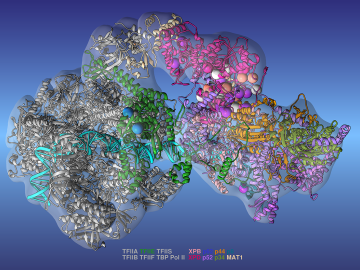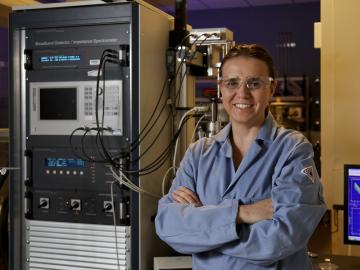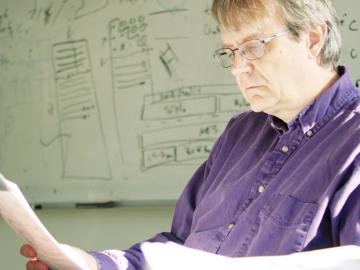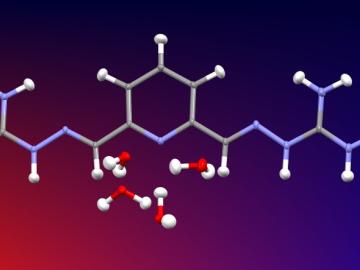
Filter News
Area of Research
- (-) Isotopes (1)
- (-) Materials (108)
- (-) Supercomputing (77)
- Advanced Manufacturing (3)
- Biology and Environment (57)
- Biology and Soft Matter (1)
- Computational Biology (2)
- Computational Engineering (2)
- Computer Science (1)
- Energy Frontier Research Centers (1)
- Energy Science (54)
- Fusion and Fission (9)
- Fusion Energy (8)
- Materials for Computing (17)
- Mathematics (1)
- National Security (11)
- Neutron Science (123)
- Nuclear Science and Technology (16)
- Nuclear Systems Modeling, Simulation and Validation (1)
- Quantum information Science (2)
News Topics
- (-) Advanced Reactors (5)
- (-) Nanotechnology (42)
- (-) Neutron Science (42)
- (-) Physics (34)
- (-) Polymers (18)
- (-) Summit (43)
- 3-D Printing/Advanced Manufacturing (26)
- Artificial Intelligence (39)
- Big Data (22)
- Bioenergy (18)
- Biology (14)
- Biomedical (27)
- Biotechnology (2)
- Buildings (8)
- Chemical Sciences (32)
- Clean Water (3)
- Composites (9)
- Computer Science (99)
- Coronavirus (17)
- Critical Materials (15)
- Cybersecurity (8)
- Energy Storage (37)
- Environment (35)
- Exascale Computing (26)
- Frontier (32)
- Fusion (8)
- Grid (9)
- High-Performance Computing (45)
- Irradiation (2)
- Isotopes (35)
- ITER (1)
- Machine Learning (15)
- Materials (79)
- Materials Science (83)
- Mathematics (2)
- Microscopy (29)
- Molten Salt (3)
- National Security (9)
- Nuclear Energy (23)
- Partnerships (11)
- Quantum Computing (21)
- Quantum Science (33)
- Security (7)
- Simulation (16)
- Software (1)
- Space Exploration (7)
- Transportation (19)
Media Contacts

Researchers have pioneered a new technique using pressure to manipulate magnetism in thin film materials used to enhance performance in electronic devices.

Scientists have discovered a way to alter heat transport in thermoelectric materials, a finding that may ultimately improve energy efficiency as the materials

Environmental conditions, lifestyle choices, chemical exposure, and foodborne and airborne pathogens are among the external factors that can cause disease. In contrast, internal genetic factors can be responsible for the onset and progression of diseases ranging from degenerative neurological disorders to some cancers.

Using Summit, the world’s most powerful supercomputer housed at Oak Ridge National Laboratory, a team led by Argonne National Laboratory ran three of the largest cosmological simulations known to date.

In a step toward advancing small modular nuclear reactor designs, scientists at Oak Ridge National Laboratory have run reactor simulations on ORNL supercomputer Summit with greater-than-expected computational efficiency.

OAK RIDGE, Tenn., March 11, 2019—An international collaboration including scientists at the Department of Energy’s Oak Ridge National Laboratory solved a 50-year-old puzzle that explains why beta decays of atomic nuclei

Vera Bocharova at the Department of Energy’s Oak Ridge National Laboratory investigates the structure and dynamics of soft materials.

More than 1800 years ago, Chinese astronomers puzzled over the sudden appearance of a bright “guest star” in the sky, unaware that they were witnessing the cosmic forge of a supernova, an event repeated countless times scattered across the universe.

Researchers used neutron scattering at Oak Ridge National Laboratory’s Spallation Neutron Source to investigate the effectiveness of a novel crystallization method to capture carbon dioxide directly from the air.

OAK RIDGE, Tenn., Feb. 8, 2019—The Department of Energy’s Oak Ridge National Laboratory has named Sean Hearne director of the Center for Nanophase Materials Sciences. The center is a DOE Office of Science User Facility that brings world-leading resources and capabilities to the nanoscience resear...


